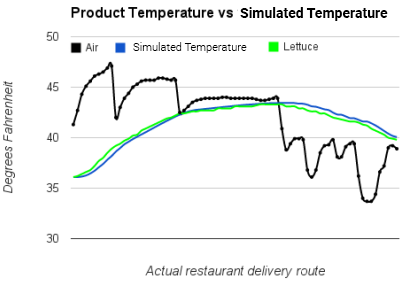Simulated Temperature Monitoring
June 01, 2017
As the requirements of FSMA start to govern your daily work life, it is important to remember that FSMA requires shippers to monitor the temperature of the product being shipped, not just the temperature of the air around it.
The basic laws of thermodynamics dictate that, given time, the core temperature of a product inside a fridge will converge with the set point of the fridge. However, time is not necessarily on the side of a shipper and it’s possible for the core product temp and the air temp to be quite different, particularly over shorter journeys.
For many shippers, air temperature monitoring remains an acceptable proxy for core temperature. But larger ‘corporate’ shippers have an established requirement for continuous core product temperature monitoring.
Up until now, obtaining core product temperature has involved penetrating the load packaging to insert a wired/wireless temperature probe. Of course, penetrating perishable goods with a physical probe is less than ideal, both from a hygiene and a practical standpoint. You would be amazed how often damage occurs when people forget to detach probes before unloading goods.
The good news, however, is that science has an answer. By knowing the thermal characteristics of the product being carried and using the detailed information available from Coretex’s iBright-powered reefer monitoring system, it’s now possible to compute the actual product temperature with a very high degree of accuracy.
These simulated temperatures work by understanding the “thermal mass” characteristics of each different product. They rely on mathematical models fed by data collected for each product type.
A large number of products, particularly food types, have already been modelled. And the models are proven, as the graphic below demonstrates. It shows a comparison of air temperature versus simulated temperature and the actual temperature of produce. The actual temperature is the green line, which is appropriate because in this case the load is lettuce. The temperatures were measured over 18 hours and what’s really noticeable is just how closely the simulated temperatures in blue match the actual temperature of the lettuce. The air temperature, on the other hand, zig zags all over the place. As a proxy for the temperature of the lettuce, it comes a very distant second to the simulation.

What does this mean for you? Simple: if you are in the refrigerated transport business but don’t want your shipment of lettuce or anything else being physically probed, then get in touch with the Coretex team. We’ll show you how simulated temperature monitoring can help your business!
- Ben Martel, Chief Science Officer, Coretex